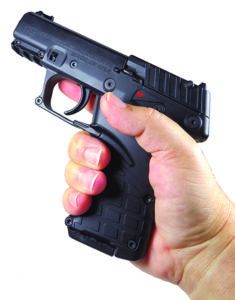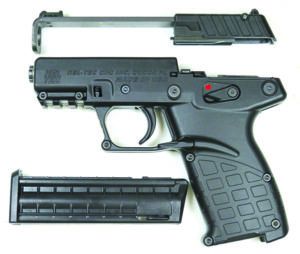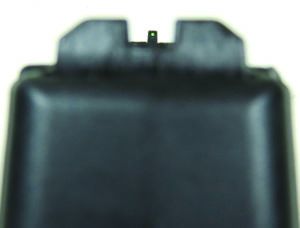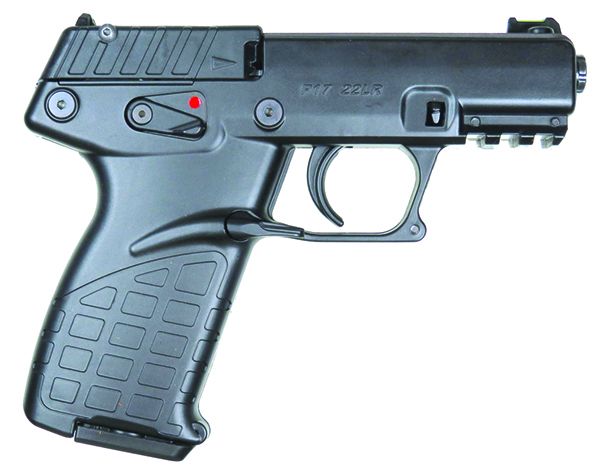GUN TESTS GRADE: A-
$199
The KelTec P17 was the lightest pistol tested, weighing 10.9 ounces unloaded. It came in a hard-plastic foam-lined case with three magazines and a suppressor adaptor. We appreciated the three magazines and the adapter. It has that distinct KelTec look of two polymer-frame halves sandwiched together with a handful of hex screws. There is not a lot of beauty in the P17’s aesthetics, in our opinion. The beauty in this pistol is its ease of use, cost, and performance at the range.
| Action Type | Blowback semi-auto, hammer fired, single action only |
| Overall Length | 6.7 in. |
| Overall Height | 5.3 in. |
| Maximum Width | 1.2 in. |
| Weight Unloaded | 10.9 oz. |
| Weight Loaded | 20.5 oz. |
| Barrel | 3.8 in. |
| Capacity | 16 |
| Slide | Black, polymer/steel |
| Slide Retraction Effort | 9.0 lbs. |
| Frame | Black, polymer |
| Frame Front Strap Height | 2.2 in. |
| Frame Back Strap Height | 3.0 in. |
| Grip | Textured polymer |
| Grip Thickness (max) | 0.9 in. |
| Grip Circumference (max) | 5.3 in. |
| Front Sight | Fiber optic front |
| Rear Sight | Adjustable, black notch |
| Trigger Pull Weight | 2.7 lbs. |
| Trigger Span | 2.7 in. |
| Magazines | 3; polymer |
| Manual Safety | Thumb lever |
| Warranty | Limited lifetime |
| Telephone | (321) 631-0068 |
| Website | KeltecWeapons.com |
| Made In | USA |
The frame is made of polymer with a grip in KelTec’s trademark large square texture. The grip is thin in hand and easy for small-handed shooters to operate. Similar to the TX22, the P17 grip funnels the user’s trigger finger toward the trigger with a ridge that forms the magazine release. The paddle magazine release is similar to the Walther P99 AS or H&K VP9. The ambidextrous paddle forms part of the bottom rear edge of the trigger guard. Press the paddle down and it dumps the magazine. Some testers do not like this European-style magazine release, while some found the paddle can easily be manipulated with the thumb of the shooting hand or the thumb of the support hand. The manual safety is also ambidextrous and is a lever. Down reveals a red dot, and the gun is ready to fire. Down blocks the trigger but still allows the slide to be manipulated.

The slide is an L-shaped piece of metal. The grip panels form two walls on either side to enclose the barrel. The barrel is fixed in place, and this, in theory, improves accuracy. The rear of slide rides on two rails build into what KelTec calls the frame. This metal piece is the serialized part and is secured between the two grip panels.
The front sight is a green-fiber-optic tube and is screwed in place with two hex screws. The adjustable rear is a black notch and the adjustment mechanism is flush with top of the slide. It does not sit on top of the slide like on the Glock and Taurus. The rear sight also had mystery adjustment with no indicators. A hex screw in front of the rear sight adjusts elevation. Turn the screw clockwise to move the sight downward and counterclockwise to move it upward. To make windage adjustments, rotate the side slide cover screw clockwise to shift groups right. We though the sights were adequate. The fiber optic looks like a glowing pin point, and we thought this was fine. In some instances, when the fiber optic is larger, it can hinder more precise target shooting, especially at close range.
The P17 has a muzzle adapter that can be attached. Use the included tool to remove the barrel nut, then attach the adaptor. Again we think this is a nice value add. Even it you don’t get a suppressor, you can add a compensator.

The slide stop is a tiny tab of metal protected by two raised ridges in the polymer grip panel to protect the slide stop from accidental engagement. The support thumb of a right-handed shooter can easily manipulate the slide stop. When the pistol is cocked and ready to fire, a square hole in the rear of slide and frame shows a red spot. With the hammer fully forward, there is no red spot. We found this hard to see and would have preferred a protruding piece that would be more tactile. There is also an accessory rail built in to the frame for a light or laser.
It took 9 pounds of effort to pull back the slide. Magazines were easy to load even without a follower button. The spring tension in the magazine was much less than a typical 22 LR magazine. The trigger had about a quarter-inch of take up and then a bit of mush that broke at 2.7 pounds on average. We rechecked our trigger-pull scale and that was the correct pull weight. It actually felt like more due to the mushiness of the trigger, but we were able to get the hang of the operation.

Going hot, we found the P17 had a definite likes and dislikes for ammo. The smallest five-shot group was with Remington Thunderbolt ammo, which measured 0.61 inches. Next best was Federal AutoMatch that measured 0.83 inches. The best we could shoot with the Winchester and CCI were 0.98 and 1.16 inches, respectively. Average groups measured 1.3 to 1.6 inches. The trigger pull was mushy and definitely not able to offer precision shooting, but our groups were good for such an inexpensive pistol. We did note the P17 had the lowest muzzle velocity and accuracy on average across all three pistols, but we are talking 10 to 20 fps and .60 inch difference. We had a few FTF and FTE malfunctions in the first few magazines. We attribute that to the P17 needing some break-in time. Afterward, we tried to limp-wrist the pistol to cause a malfunction but were unable to make it fail. Due to its light weight, we did notice more recoil with the P17, not that it was uncomfortable. It was easy to seat the magazines, and they fell free when we worked the paddle release.
Our Team Said: The P17 offers light weight, accuracy, and low cost. The reliability was good after break in. The trigger pull is not P17’s strong point. We had fun running this pistol, and if tin cans are your quarry, you’d be hard pressed to find a better plinker at this cost.
Range Data
To collect accuracy data, we fired five-shot groups from a bench using a rest. Distance: 15 yards with the with open sights. We recorded velocities using a ProChrono digital chronograph set 15 feet from the muzzle.| Federal AutoMatch Target 22 Long Rifle 40-grain LRN | Glock G44 | KelTec P17 | Taurus TX22 |
| Average Velocity | 915 fps | 913 fps | 912 fps |
| Muzzle Energy | 74 ft.-lbs. | 74 ft.-lbs. | 74 ft.-lbs. |
| Smallest Group | 0.44 in. | 0.83 in. | 0.51 in. |
| Average Group | 0.63 in. | 0.93 in. | 0.71 in. |
| Remington Thunderbolt 22 Long Rifle 40-grain LRN | Glock G44 | KelTec P17 | Taurus TX22 |
| Average Velocity | 945 fps | 919 fps | 921 fps |
| Muzzle Energy | 88 ft.-lbs. | 75 ft.-lbs. | 75 ft.-lbs. |
| Smallest Group | 0.68 in. | 0.61 in. | 0.43 in. |
| Average Group | 0.70 in. | 0.91 in. | 0.66 in. |
| Winchester Xpert HV 22 Long Rifle 36-grain HP | Glock G44 | KelTec P17 | Taurus TX22 |
| Average Velocity | 924 fps | 988 fps | 991 fps |
| Muzzle Energy | 68 ft.-lbs. | 78 ft.-lbs. | 79 ft.-lbs. |
| Smallest Group | 1.00 in. | 0.98 in. | 0.75 in. |
| Average Group | 1.06 in. | 1.65 in. | 1.04 in. |
| CCI Blazer 22 Long Rifle 38-grain LRN | Glock G44 | KelTec P17 | Taurus TX22 |
| Average Velocity | 1016 fps | 989 fps | 999 fps |
| Muzzle Energy | 87 ft.-lbs. | 83 ft.-lbs. | 84 ft.-lbs. |
| Smallest Group | 0.57 in. | 1.16 in. | 0.75 in. |
| Average Group | 0.67 in. | 1.22 in. | 0.87 in. |





























